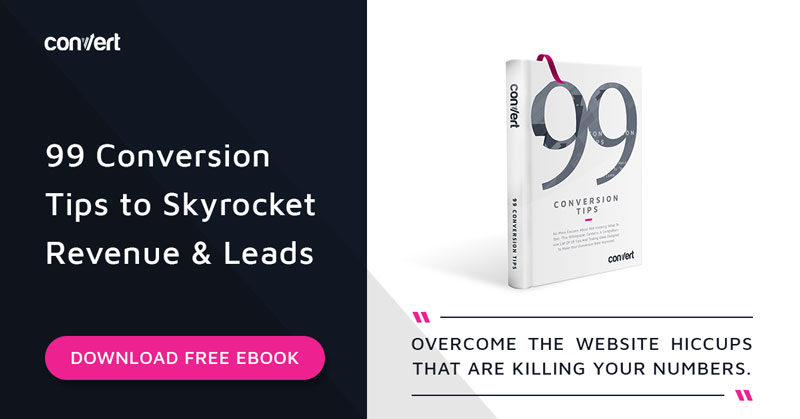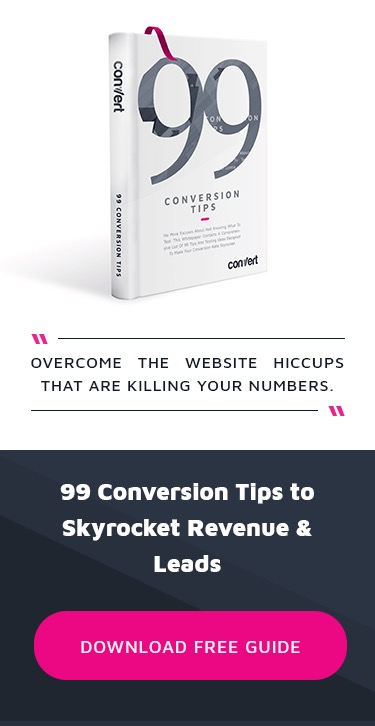Psychological Principles in CRO: 10 “Mind Magic” Tips to Predictably Improve Conversions
Imagine that you run a local art store. Shoppers come by, they look at your paintings, and they immediately leave without saying hi and without showing any interest. You know you have a problem.
The ideal situation? They would enter the store, look at the paintings, interact with you, ask questions, seek suggestions, and in the end, they would eventually buy a painting or promise to buy the next time their budget allowed them to.
In the online environment, the situation is no different. Your website visitors are coming and leaving. Your job is to make their stay interactive, interesting and action inducing.
You’ll need to make them listen, act, and finally convert. That’s a hell of a road, and it’s your responsibility.
Turning cold visitors into leads and then into customers is the automated cycle that every brand is fighting to improve.
Thankfully though there is a science for it. The science of CRO.
What is Psychological CRO?
CRO stands for Conversion Rate Optimization. But you already know that.
Psychological CRO is the art of applying psychological principles and knowledge about human biases to frame CRO hypotheses.
Psychological CRO strategies take advantage of what humans do, as a default, and give that flow a structure so that optimization professionals can use best practices – like the .99 in retail pricing which actually comes from the prospect theory – to predictably improve conversion rates across websites.
In today’s blog we will go over 10 of the most effective psychological CRO principles that have worked again and again for different industries and buyer personas.
1. Repeat Your CTA Several Times
The first step you can take to ensure that your visitors get enough chances to convert is to repeat your CTA buttons several times throughout your pages.
Let’s say your visitor starts with the homepage, he reads the heading, and then he scrolls down to the subheading. He’ll come across a CTA that he ignores, and then he moves on to the next section. After he reads your features, or testimonials, or whatever element you’ve placed next, he’ll gain a little more trust.
Your next CTA should show up, with the same text or with different text. The timing matters a lot because your visitors are taking only so long before they click on something or exit your page. Therefore, encouraging them to take immediate action multiple times can improve the odds of conversion.
2. Aggravate Problems, Satisfy Needs
When visitors arrive, they come through different channels and for various motives. All of us do our very best to seek pleasure and avoid pain. This involves problems and needs. Therefore, when visitors look for information and products, they’re basically saying “I want to improve my life.”
To achieve a great optimization rate, you’ll need to deliver two things: a fine experience and a great deal of value.
Most people who optimize their websites obsess over the details and they fail to cover the most important part, which is the visitor’s intention, problem, and need.
When you develop content, make sure that it touches on all the things that are not right in the readers’ life because of the one problem they are seeking to solve. Ensure that as the prospects empathize with the introduction, they are drawn into the body of what you have to say and stumble upon multiple nuggets of gold in the process.
Paint pictures of what they can achieve, if only they can bid good-bye to their issues. This is called future pacing. And then wrap up with a strong CTA that promises immediate gratification.
3. Get Agreement First
Throughout your sales process, you’ll need to introduce yourself, give free value, offer insightful advice, keep your visitors hooked in the funnel, and get agreement to deliver various material.
A great way to improve conversions is by “dating” them first.
Don’t jump in with a big ask. Get agreement to hold their hands and show up in their inbox. This can be through your monthly newsletter or in the form of a (consented for) nurturing series post a lead magnet download.
Once the relationship is strong and mutually rewarding in the eyes of your prospects, then ease into more promotional nudges like Demo CTAs (if you’re a SaaS business), trip wires (if you sell digital products) and sales coupons (if you’re good, ole ecommerce).
4. Bring Strong Social Proof to the Table
Most people are following the crowd, either consciously or subconsciously. Your website is small, the internet is absolutely huge. People are aware of their options, and they’re always looking for the most reliable information, products, and services.
The simplest way to instantly impact your customer’s trust is to offer strong social proof in the form of testimonials.
If respected members of the internet/local community are vouching for you, the people who will interact with your brand will unconsciously believe what you’re saying and what you’re promoting. Why? Because humans do not like to be off the tread path. We find comfort in the flock. And influencer testimonials or just the honest words of other happy customers give them incentive to join your tribe to experience the great benefits first-hand.
5. Give FREE Information and Value
As your conversion rates always rely on your customer’s behavior and their behavior is often influenced by their trust in your brand, your website should offer something that’s hard to turn down: free stuff.
It can come in the form of written content (e-book, case study, a collection of useful resources, etc.), in the form of a free call, a free consultation, or perhaps a free sample of the products you’re selling. You need to get creative, think out-of-the-box, and align with your prospects’ deepest needs and desires.
If your free information is appreciated, the prospect will long for more because he’ll perceive you as a real benefit in his life. Most brands offer free stuff in exchange for the visitors’ emails, therefore developing email marketing campaigns that produce automatic conversions and sales.
6. Offer Clear Instructions
When your visitors click on a link and enter your site, you’ll need to hook their attention immediately and preserve it until the end of the process.
Your sales process is different than other businesses’, so you’ll have to develop an effective strategy that’ll gradually increase your prospects’ trust, attention, and interest.
Talk to your visitors like I talk to you. Ask them questions, tell them interesting facts or stories, and present them with the benefits they’re mostly looking for. Promise those benefits but don’t deliver them yet. Give them instructions – sign up here, like this page, comment on this post, leave feedback – you can use all sorts of direct approaches to give clear instructions while keeping the attention hooked!
7. Give Them the “Why”
When you give your visitors directions, you should often tell them why. You can’t know everything about your prospects. What you can do, though, is let them know your intentions. If you encourage someone to read an important post from your blog, tell them why that experience will better their lives.
If you ask for their permission to send regular emails, give them a clear “why”, letting them know what to expect, when to expect it, and the benefits that come with it.
Very often, your prospects won’t consciously understand why they’re on your page. When you remind that they need help and then help them visualize a positive end result, they’ll be tempted to take more actions and to convert faster.
8. Talk to Your Customers Directly
Producing changes in your marketing strategy can often come with risks. Some of your moves won’t lead to improvements. On the contrary, they might just damage your business performance.
To minimize the risk of your optimization moves, you can talk to your leads and customers directly in order to get real insights, spoken by the persons who trusted you enough to offer you their time, attention, and money.
9. Offer Personalized Experiences
Today’s digital marketing features allow you to offer your website visitors personalized and customized experiences based on various factors such as their interests, country, device, search history, previous actions taken on your site, actions taken on your emails, and much more.
Every big brand is working with data that offers insights into visitors’ online behavior. Whether you’re working with WordPress or you’re using a customized website theme, you should implement strategic analytics that will gather feedback describing your visitors’ behavior, preferences, turn-offs, and more.
There are plenty of digital marketing analysis tools out there. I would advise you try more services until you find the ones that do the most for your businesses.
Once you’ve gathered enough insights, you’re ready to offer personalized experiences.
You can do so by creating different sets of rules like:
- If a visitor comes from {Country Name}, the website will load in {Country’s native language}
- If a visitor becomes a subscriber when he was searching for {X, Y, or Z keywords}, he will receive specific emails that are relevant to his previous search intent.
- If an email subscriber doesn’t open his emails frequently, automatically put him in a different list that’s focused on bringing the attention back to your value propositions.
For example – if the keyword “cheap essay writing services” attracts bad traffic and the keyword “cheap and quality essay writing services” brings traffic that constantly converts, you’ve got a good insight. People that are looking for both cheap and quality need different triggers and perhaps require more trust and credibility than those who only look for cheap. Therefore, the CTAs and the benefits propositions on each page should be different so that the content can build rapport with both potential audiences.
You can think about different strategies, implement them one by one, test them until you gather decent data to draw conclusions, and assess the results. If they’re positive, scale your efforts. If they’re negative, keep personalizing and optimizing!
10. Don’t Think You Know – Test Everything
The biggest mistake would be to assume that you know everything about your target audience. Another would be to ignore your target audience’s needs and test your optimization ideas without enough justification.
To bring efficiency in your optimization, you’ll need to “play” with solid data. As I’ve mentioned above, there are so many solutions that will bring amazing insights concerning your visitors, email subscribers, and customers’ mindset and behavior.
I would suggest you A/B test your campaigns multiple times, gather palpable feedback, assess it together with a team of professional marketers, and draw the conclusions later.
Seeking and implementing non-documented changes is a risky practice. You can get it right, but you never know how disempowering it can get. When you analyze your traffic on a consistent basis and test your premises in an elaborate and precise fashion, you won’t count on luck.
This is the End. Now What?
So how do you implement these tips in your business?
It’s tempting to go the whole hog and start with multiple changes. But reason says practice makes perfect. Go with the approach that you feel your online presence needs the most right now, keep at it till you see results and then move on to the next.
Once you understand exactly why your visitors take action and spend money on your website, you can apply that understanding to a lot more than marketing or design.
You can create an entire business that is in tune with your market’s rhythm.
Written By
Susan Saurel


